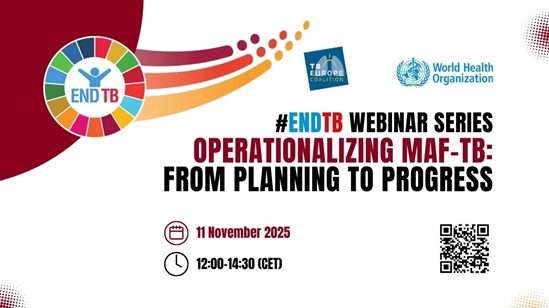#EndTB Webinar: Multisectoral engagement to address the social determinants and key drivers of the TB epidemic – World Health Organization (WHO)

Event Report: #EndTB Webinar on Multisectoral Engagement and Sustainable Development Goals
Introduction and Alignment with Global Goals
A report on the upcoming international #EndTB webinar, a collaborative initiative aimed at accelerating progress towards the Sustainable Development Goals (SDGs). This event is part of a series dedicated to operationalizing the Multisectoral Accountability Framework to End TB (MAF-TB).
- Organizers: The World Health Organization (WHO) in collaboration with the TB Europe Coalition (TBEC).
- Primary Objective: To advance the global commitment to end the tuberculosis epidemic by 2030, directly addressing SDG 3 (Good Health and Well-being), specifically Target 3.3.
- Framework: The webinar series focuses on the implementation of the MAF-TB as a critical tool for achieving multisectoral action and accountability.
Webinar Focus: A Multisectoral Approach to Achieving the SDGs
The second webinar in the global series will concentrate on catalyzing action to address the social determinants and key drivers of the TB epidemic. This approach underscores the interconnected nature of the SDGs, highlighting that progress in health is contingent upon advancements in other sectors.
The event will emphasize how strengthened collaboration across key sectors can accelerate progress towards ending TB and achieving related SDGs:
- Social Protection: Addressing the poverty-related drivers of TB, contributing to SDG 1 (No Poverty) and SDG 10 (Reduced Inequalities).
- Nutrition: Tackling malnutrition as a significant risk factor for TB, in line with SDG 2 (Zero Hunger).
- Labour: Ensuring safe working environments and protecting workers’ rights to mitigate occupational TB risks, supporting SDG 8 (Decent Work and Economic Growth).
- Justice: Upholding a rights-based approach to TB care, particularly for vulnerable and incarcerated populations, which aligns with SDG 16 (Peace, Justice and Strong Institutions).
This multisectoral strategy is a practical application of SDG 17 (Partnerships for the Goals), fostering collaboration between diverse stakeholders to achieve a common objective.
Event Details and Objectives
- Date: Tuesday, 11th November 2025
- Time: 12:00 to 14:30 CET
- Format: An interactive webinar designed to facilitate dialogue, feedback, and the sharing of national experiences in operationalizing the MAF-TB.
- Languages: Simultaneous interpretation will be available in English, French, and Russian.
Participants and Stakeholder Engagement
The event will convene a broad range of stakeholders, reflecting the multisectoral partnership model required by SDG 17 to achieve Health for All.
- WHO leadership
- Representatives from ministries of health and national TB programmes
- Donors and funding agencies
- Civil society organizations
- Communities affected by TB
The webinar is open to all stakeholders committed to the global fight against TB and the achievement of the Sustainable Development Goals.
Analysis of Sustainable Development Goals in the Article
1. Which SDGs are addressed or connected to the issues highlighted in the article?
The article, which announces a webinar on ending Tuberculosis (TB), connects to several Sustainable Development Goals by emphasizing a multisectoral approach that addresses the root causes of the disease. The following SDGs are relevant:
- SDG 3: Good Health and Well-being: This is the primary goal addressed. The article’s entire focus is on the “#EndTB” initiative and the “fight against TB,” which is a major global health issue and a specific target within this goal. The mention of achieving “Health for All” further reinforces this connection.
- SDG 1: No Poverty: The article highlights the need to address “social determinants” of TB and explicitly names “social protection” as a key sector for collaboration. Poverty is a primary social determinant of TB, and social protection systems are a core strategy for poverty reduction.
- SDG 2: Zero Hunger: The article identifies “nutrition” as one of the key sectors for collaboration. Malnutrition significantly weakens the immune system and is a well-established risk factor for developing active TB. Addressing nutrition is crucial for both preventing and treating the disease.
- SDG 8: Decent Work and Economic Growth: The inclusion of the “labour” sector as a partner indicates a connection to this goal. Factors such as poor working conditions, low wages, and lack of job security can increase vulnerability to TB. Engaging the labour sector is essential to protect workers’ health.
- SDG 16: Peace, Justice and Strong Institutions: The article mentions the “justice” sector as a necessary partner. Vulnerable populations, such as those in prisons or detention centers, often face a higher risk of TB transmission. Ensuring access to health services within the justice system is critical for an effective TB response.
- SDG 17: Partnerships for the Goals: The core theme of the webinar is “Multisectoral engagement” and “strengthened collaboration.” The event itself is a partnership between the “World Health Organization (WHO)” and the “TB Europe Coalition (TBEC),” involving “ministries of health,” “donors,” “civil society organizations,” and “communities affected by TB.” This embodies the spirit of multi-stakeholder partnerships to achieve sustainable development.
2. What specific targets under those SDGs can be identified based on the article’s content?
Based on the issues discussed, the following specific SDG targets can be identified:
- Target 3.3: “By 2030, end the epidemics of AIDS, tuberculosis, malaria and neglected tropical diseases…” The article’s central theme, encapsulated by the “#EndTB” hashtag and the focus on ending the “TB epidemic,” directly aligns with this target.
- Target 3.8: “Achieve universal health coverage…” The article’s stated goal of achieving “Health for All” is a direct reference to the principles of universal health coverage, which is the focus of this target.
- Target 1.3: “Implement nationally appropriate social protection systems and measures for all…” The call to strengthen collaboration with the “social protection” sector to address TB’s drivers is a direct link to implementing and expanding social protection systems to support vulnerable populations.
- Target 2.2: “By 2030, end all forms of malnutrition…” The emphasis on engaging the “nutrition” sector to tackle the key drivers of TB implies an effort to combat malnutrition, which is a major risk factor for the disease.
- Target 17.17: “Encourage and promote effective public, public-private and civil society partnerships…” The webinar itself is an example of this target in action. It is a collaborative event organized by WHO and TBEC, bringing together a wide range of stakeholders from government, civil society, donors, and affected communities to advance the “Multisectoral Accountability Framework to End TB (MAF-TB).”
3. Are there any indicators mentioned or implied in the article that can be used to measure progress towards the identified targets?
The article, being a webinar announcement, does not explicitly state any quantitative indicators. However, the goals and themes discussed strongly imply the use of specific official SDG indicators to measure progress:
- Implied Indicator for Target 3.3: The overarching goal to “#EndTB” implies the need to measure the burden of the disease. The relevant indicator would be Indicator 3.3.2: Tuberculosis incidence per 100,000 population. Reducing this incidence rate is the primary measure of success in ending the TB epidemic.
- Implied Indicator for Target 1.3: The focus on strengthening the “social protection” sector to address TB suggests that progress would be measured by the reach of these systems. The relevant indicator is Indicator 1.3.1: Proportion of population covered by social protection floors/systems, by sex, distinguishing children, unemployed persons, older persons, persons with disabilities, pregnant women, newborns, work-injury victims and the poor and the vulnerable.
- Implied Indicator for Target 17.17: The article describes the “Multisectoral Accountability Framework to End TB (MAF-TB)” and the collaborative nature of the webinar. While not a quantitative metric, the establishment and operationalization of such multi-stakeholder partnerships serve as a qualitative indicator of progress towards this target. The success of the MAF-TB framework itself would be a measure of effective partnership.
4. Table of SDGs, Targets, and Indicators
| SDGs | Targets | Indicators (Implied from the article) |
|---|---|---|
| SDG 3: Good Health and Well-being | Target 3.3: End the epidemics of AIDS, tuberculosis, malaria and neglected tropical diseases. | Indicator 3.3.2: Tuberculosis incidence per 100,000 population. |
| SDG 1: No Poverty | Target 1.3: Implement nationally appropriate social protection systems and measures for all. | Indicator 1.3.1: Proportion of population covered by social protection floors/systems. |
| SDG 2: Zero Hunger | Target 2.2: End all forms of malnutrition. | The article implies a focus on reducing malnutrition as a risk factor for TB, aligning with indicators measuring the prevalence of malnutrition. |
| SDG 17: Partnerships for the Goals | Target 17.17: Encourage and promote effective public, public-private and civil society partnerships. | The existence and implementation of the “Multisectoral Accountability Framework to End TB (MAF-TB)” serves as a qualitative indicator of multi-stakeholder partnership. |
Source: who.int
What is Your Reaction?
 Like
0
Like
0
 Dislike
0
Dislike
0
 Love
0
Love
0
 Funny
0
Funny
0
 Angry
0
Angry
0
 Sad
0
Sad
0
 Wow
0
Wow
0














































.jpg.webp?itok=0ZsAnae9#)







:focal(1500,1000)/https://media.globalcitizen.org/a6/9a/a69a4720-d8a1-4715-b596-18738d03c05c/rotary_polio_hero_image.jpg?#)

/countries/sri-lanka/photo-credit---dmc-sri-lanka.tmb-1200v.jpg?sfvrsn=dc298bcc_1#)



















